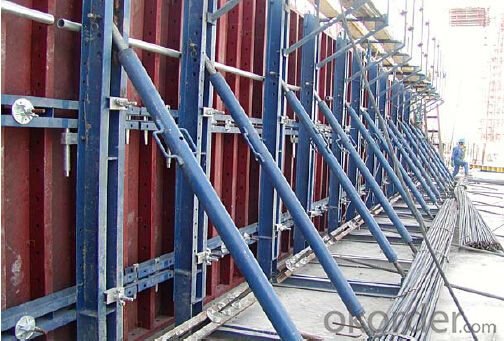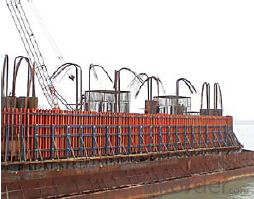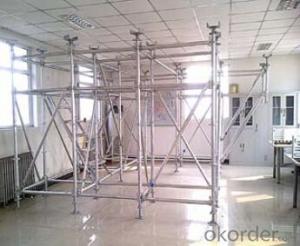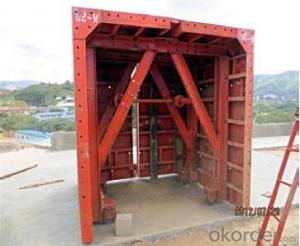Single-side Climbing Bracket SCB180 for formwork and scaffolding systems
- Loading Port:
- Tianjin
- Payment Terms:
- TT OR LC
- Min Order Qty:
- 50 m²
- Supply Capability:
- 1000 m²/month
OKorder Service Pledge
OKorder Financial Service
You Might Also Like
Single-side Climbing Bracket SCB180:
With CNBM SCB 180 climbing systems, the loads from the fresh concrete pressure are transferred through the brackets by means of V-strongbacks and compression braces into the scaffold anchors.
Typical applications for the SCB 180 are dams, locks, cooling towers, pier heads, tunnels, and bank vaults.
The formwork is simply tilted backwards when striking takes place. The 1.80 m wide bracket requires only a minimum of space.
Characteristics:
◆ Economical and safe anchoring
The M30/D20 climbing cones have been designed especially for single-sided concreting using
SCB180 in dam construction, and to allow the transfer of high tensile and shear forces into the still
fresh, unreinforced concrete. Without wall-through tie-rods, finished concrete is perfect.
◆ Stable and cost-effective for high loads
generous bracket spacings allow large-area formwork units with optimal utilization of the bearing
capacity. This leads to extremely economical solutions.
◆ Simple and flexible planning
With SCB180 single-sided climbing formwork, circular structures can also be concreted without
undergoing any large planning process. Even use on inclined walls is feasible without any special
measures because additional concrete loads or lifting forces can be safely transferred into the
structure.
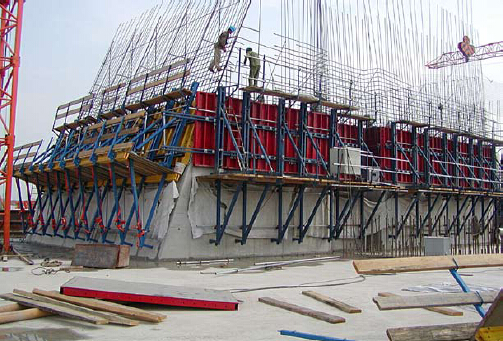
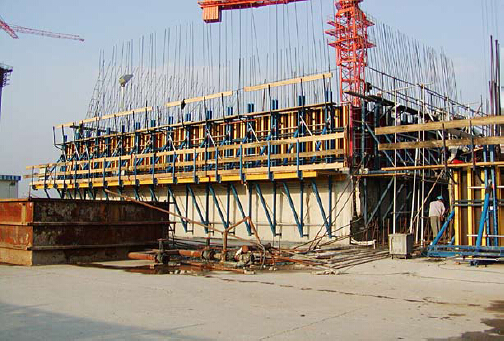
- Q: How does steel formwork affect the structural integrity of a building?
- Steel formwork can greatly enhance the structural integrity of a building. Its rigid and durable nature ensures accurate and consistent placement of concrete, resulting in a stronger and more reliable structure. The use of steel formwork also allows for greater flexibility in design, enabling complex architectural features and reducing the need for additional support elements. Overall, steel formwork plays a crucial role in ensuring that a building maintains its structural stability and meets the required safety standards.
- Q: How is steel formwork transported to the construction site?
- Steel formwork is typically transported to the construction site by using trucks or trailers equipped with cranes or forklifts. The formwork is securely loaded onto the vehicle and then transported to the site, where it is unloaded and positioned for use in the construction process.
- Q: What are the maintenance requirements for steel formwork?
- The maintenance requirements for steel formwork typically involve regular cleaning to remove any debris or concrete buildup, inspection for signs of wear or damage, and occasional repairs or replacement of damaged components. Additionally, applying a protective coating or rust inhibitor can help prevent corrosion and prolong the lifespan of the formwork.
- Q: How does steel formwork affect the overall construction site logistics?
- The overall construction site logistics can be significantly impacted by steel formwork. Firstly, the durability and strength of steel formwork allow for multiple reuses, reducing the need for constant replacement and disposal of materials. This results in reduced waste generation and improved site cleanliness. Moreover, steel formwork is lightweight and easily adjustable, making it easier to handle and transport around the construction site. This improves material handling efficiency and reduces the time required for installation and removal of formwork. Additionally, the lightweight nature of steel formwork reduces the load on the structure, leading to reduced transportation costs and improved safety during construction. Furthermore, steel formwork offers high dimensional accuracy, ensuring precise and consistent shapes for concrete elements. This helps streamline the construction process by reducing the need for excessive adjustments and rework, resulting in improved time management and increased productivity. Additionally, steel formwork provides a smooth and even finish to concrete structures, eliminating the need for additional surface treatments and reducing the time and effort required for finishing work. In summary, steel formwork contributes to improved construction site logistics by reducing waste, enhancing material handling efficiency, improving construction speed, and ensuring high-quality finishes. Its durability, lightweight nature, and dimensional accuracy make it a valuable asset in optimizing construction processes and achieving project timelines more effectively.
- Q: How does steel formwork affect the overall project budget?
- Steel formwork can have a significant impact on the overall project budget. While it may initially have a higher upfront cost compared to other formwork materials, such as wood or plastic, steel formwork offers several advantages that can help offset these expenses. Steel formwork is durable, reusable, and has a longer lifespan, reducing the need for frequent replacements or repairs. Additionally, its strength allows for a higher number of concrete pours, increasing productivity and minimizing downtime. These factors, along with reduced labor costs and improved efficiency, make steel formwork a cost-effective choice in the long run, ultimately positively impacting the project budget.
- Q: Can steel formwork be used for retaining walls?
- Yes, steel formwork can be used for retaining walls. Steel formwork is a popular choice for retaining walls due to its durability and strength. It provides excellent support and stability to the concrete during the construction process. Steel formwork is capable of withstanding the pressure exerted by the concrete and the soil behind the retaining wall, ensuring that the structure remains intact. Additionally, steel formwork offers flexibility in terms of shape and size, allowing for the construction of various retaining wall designs. Overall, steel formwork is a reliable and efficient choice for retaining walls, offering long-lasting performance and ease of construction.
- Q: How does steel formwork contribute to the overall sustainability of the construction industry?
- Steel formwork contributes to the overall sustainability of the construction industry in several ways. Firstly, steel formwork is highly durable and long-lasting. It can be reused multiple times, reducing the need for new formwork materials for each construction project. This significantly reduces the amount of waste generated during the construction process and minimizes the overall environmental impact of the industry. Additionally, steel formwork is a more sustainable alternative to traditional formwork materials such as timber. Timber formwork often requires cutting down trees, which contributes to deforestation and habitat destruction. By utilizing steel formwork, we can reduce our reliance on timber and help preserve forests. Steel formwork also offers greater structural stability and strength compared to other materials. This allows for more efficient construction processes and reduces the need for additional support structures. As a result, less material is wasted, energy is saved, and the overall construction time is shortened, making the process more sustainable. Furthermore, steel formwork is highly resistant to weather conditions, corrosion, and fire. This ensures the longevity of the buildings, reducing the need for frequent repairs or replacements. By using steel formwork, we can create structures that have a longer lifespan, resulting in reduced resource consumption and waste generation over time. Lastly, steel formwork is recyclable. At the end of its life cycle, steel formwork can be easily melted down and reused for other applications. This reduces the demand for new steel production, conserving natural resources and reducing energy consumption. In conclusion, steel formwork contributes to the overall sustainability of the construction industry by being durable, reusable, resistant to weather conditions, and recyclable. Its use helps minimize waste generation, deforestation, energy consumption, and resource depletion, making it an environmentally-friendly choice for construction projects.
- Q: Can steel formwork be used for both slab and column construction?
- Yes, steel formwork can be used for both slab and column construction. Steel formwork offers several advantages over other types of formwork, such as wood or plastic. It is highly durable and can withstand the pressure exerted by fresh concrete, making it suitable for use in both slab and column construction. For slab construction, steel formwork provides a strong and rigid support system, ensuring that the concrete is poured and cured in the desired shape and dimensions. The steel panels can be easily assembled and disassembled, allowing for efficient and repeated use on multiple projects. This saves both time and money in the long run. Similarly, steel formwork can also be used for column construction. The adjustable panels can be easily customized to various column sizes and shapes, providing flexibility in design. Steel formwork also offers a smooth surface finish, resulting in high-quality columns. Moreover, steel formwork is resistant to warping, swelling, and shrinking, which can occur with other types of formwork materials. This ensures that the concrete structure is built accurately and maintains its structural integrity over time. Overall, steel formwork is a versatile and reliable option for both slab and column construction. Its strength, durability, and ease of use make it a popular choice among construction professionals.
- Q: Can steel formwork be used for tunnel construction?
- Tunnel construction can make use of steel formwork, which are molds made from steel that shape and support concrete during the building process. Steel formwork is commonly employed in tunnel construction to create the tunnel lining. This lining provides both structural support and protection from external forces. The use of steel formwork in tunnel construction offers several advantages. Firstly, steel formwork possesses strength and durability, making it capable of withstanding the pressures and forces exerted on the tunnel structure. As a result, it is suitable for constructing tunnels in various ground conditions, including soft soils, rock, or even underwater. Secondly, steel formwork is highly customizable, allowing for flexibility in tunnel design. It can be prefabricated off-site and then assembled on-site, reducing both construction time and costs. Moreover, steel formwork can be reused, enhancing its cost-effectiveness and sustainability. Furthermore, steel formwork provides a smooth and high-quality finish to the tunnel lining. This ensures the structural integrity and longevity of the tunnel. Additionally, it allows for the easy installation of other tunnel components, such as electrical conduits, ventilation systems, and drainage pipes. However, it is important to consider various factors when selecting the appropriate formwork material, including tunnel dimensions, construction method, ground conditions, and project requirements. Depending on the specific needs of the project, materials such as timber or aluminum may also be suitable for tunnel construction.
- Q: What are the common safety training requirements for steel formwork installation?
- Common safety training requirements for steel formwork installation typically include: 1. Fall protection training: Workers must be trained on proper harness and fall protection equipment usage to prevent falls from heights during installation. 2. Hazard communication training: Workers should be educated on the potential hazards associated with steel formwork installation, such as heavy lifting, sharp edges, and potential collapse, and how to mitigate these risks. 3. Equipment operation training: Proper training on the use and maintenance of tools and equipment specific to steel formwork installation, such as cranes, hoists, and concrete pumps, is necessary to ensure safe operation. 4. Material handling training: Workers need to learn proper techniques for lifting, carrying, and placing steel formwork components to prevent injuries related to overexertion, strains, and sprains. 5. Structural stability training: Understanding the structural integrity of the formwork system and how to identify signs of instability or failure is crucial for ensuring worker safety during the installation process. 6. Emergency response training: Workers should receive training on emergency procedures, including evacuation plans, first aid, and the proper use of fire extinguishers, in case of accidents or incidents on the job site. These are some of the common safety training requirements for steel formwork installation, but specific regulations and additional training may vary depending on the country, industry standards, and project requirements.
Send your message to us
Single-side Climbing Bracket SCB180 for formwork and scaffolding systems
- Loading Port:
- Tianjin
- Payment Terms:
- TT OR LC
- Min Order Qty:
- 50 m²
- Supply Capability:
- 1000 m²/month
OKorder Service Pledge
OKorder Financial Service
Similar products
Hot products
Hot Searches


